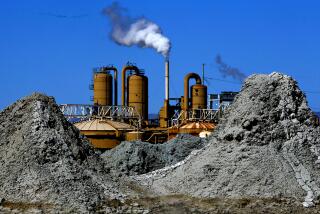Why Perth is booming
Three kinds of boomtowns have emerged in the last decade. The dot-com era created brainy, culturally savvy, “hip” cities such as Boston, San Francisco, Berlin, Montreal and Sydney. But they turned into very expensive places in which to do business and for the middle class to live.
Low-cost cities became the new boomtowns after the bubble economy burst in 2000. Business and tech firms headed to Phoenix, Reno and Fort Myers, Fla., and other no-nonsense, middlebrow places.
Now, the prospect of persistently high energy prices has fueled the latest wave of boomtowns, Rodney Dangerfield-like places that are finally getting respect -- Calgary, Canada; Nagoya, Japan; Perth, Australia; Casper, Wyo., and Midland, Texas.
Calgary, Canada’s energy capital, is arguably North America’s fastest-growing major city. Located near the vast oil sands of Alberta province, the city is deluged with thousands of new residents from throughout Canada and from around the world seeking jobs and opportunities. Although its low taxes and business-friendly environment made it a thriving city before the high energy prices, it’s really booming now.
Downtown Calgary is a deja vu version of urbanity in its heyday. At a time when many cities -- Los Angeles, Chicago and San Francisco, among them -- are busily converting redundant office space into high-priced condos, Calgary’s downtown has the lowest office vacancy rate -- a paltry 1.7%, according to one estimate -- of any North American city. More than a million additional square feet are planned for downtown and another million for the city’s burgeoning suburbs.
The big problem in Calgary is not finding a job but finding workers. From March 2005 to March 2006, the city added almost 45,000 full-time positions -- about an 8% growth rate. The manpower shortfall is felt across Alberta.
Calgary is exceptional, but other energy and resource-rich places are similarly benefiting from high energy prices. The Australian states of Queensland and Western Australia, for instance, are two such places. Both families and young singles are moving there and settling in such relatively affordable cities as Brisbane and Perth, long dismissed as cultural backwaters but now widely seen as offering a better shot at realizing the “Australian dream” of a single-family house and a bigger paycheck.
Because commodities represent a smaller part of the U.S. economy, the boomtown phenomenon has been slower to emerge. Yet high oil prices have set off undeniable changes in such energy-producing areas as Wyoming, which sat at the bottom of income growth in the 1990s but is now getting richer faster than any other state.
Two of its towns, Casper and Gillette, for instance, are filling up with workers from the rest of the country, as well as immigrants. Using new oil-exploration technology, wildcatters are reopening long-neglected fields in eastern Montana and in the Dakotas.
Since 2000, Wyoming has enjoyed the fastest growth in personal income of any state, according to one recent survey. Such unlikely places as Montana, North Dakota, New Mexico and coal-rich West Virginia are not far behind. The job bases in these states and their region have expanded at rates greater than the national norm.
The biggest obstacle to future growth, as in Alberta, Queensland and Western Australia, is too few skilled workers. Energy companies are scouring the industrial Midwest for welders, electricians, mechanics and other skilled blue-collar workers to keep the oil wells pumping.
Alternative energies are driving economic boom times in the eastern edge of the Great Plains, where several new energy-producing projects have been built and many more proposed. In Fargo and Grand Forks, N.D.; Sioux Falls, S.D., and Omaha, the talk is about the growth of manufacturing jobs, rising farm prices -- and ethanol, which is made from corn, as an alternative fuel for cars, as well as wind power, which the Great Plains possesses in abundance.
Perhaps the biggest long-term winner in the energy sweepstakes will be Texas, where job growth has languished under the presidency of its former governor. Until recently, West Texas oil-exploration firms, said Midland oilman Mike Bradford, had held back from drilling because they feared the high oil prices would not last.
Now they are convinced that the energy market has broken free of OPEC control and that prices will remain high. “We think high [oil and gas] prices are for real -- and we’re going nuts,” said Bradford, who also sits on the Midland County Commission.
Bradford said there were barely 100 houses available for sale in Midland, down from 500 about a year ago. Unemployment, once well above the national average, is virtually nonexistent. Office vacancy rates, near 50% a few years back, have dropped to about 10%.
Houston may be the big city with the most to gain from continued high energy prices. Over the last decade, it relied largely on the huge Texas Medical Center, growing economic diversity, immigrant businesses and low housing costs to keep its economy running at close to the national norm. Energy’s contribution to Houston’s economy dropped from 82% in the 1970s to less than half today. But with local energy firms returning to the oil fields, job growth this year may exceed 3%, roughly twice the national average, according to Houston Federal Reserve economist Bill Gilmer.
The effects of high energy prices also have turned economies that specialize in developing technologies to overcome them into boomtowns. The most stunning example is Nagoya, the headquarters of Toyota and the de facto worldwide center for energy-efficient transportation. Toyota’s hybrid engine, most closely associated with the Prius, is widely considered to have the inside track for the next generation of cars.
For decades, the western Japanese metropolis paled beside the glitter of Tokyo. It was caricatured as a doughty, thrifty factory town -- the center for the Japanese culture of monozukuri, or making things. But even Tokyo economists refer to Japan’s current economic expansion, based on energy-smart innovation, as “the Nagoya boom.” Nagoya-based manufacturers account for roughly half the U.S. trade deficit with Japan. And as in the U.S., Canadian and Australian energy belts, there is a huge surplus of jobs, with 1.6 positions for every available worker.
In light of the historical growth patterns of the energy industry, it would be foolish to identify these cities as long-term boomtowns. As any Houston real estate developer or wildcatter can tell you, energy-based growth can slacken, sometimes quite suddenly.
Yet, whether in Japan, Australia or North America, the cities that flourish will be those that stick to the basics -- producing goods and services for the global market, providing opportunities for middle-class citizens and a favorable environment for local businesses.
This may be less appealing to some than the hipster mantra of the late 1990s, but it also is something infinitely more sustainable.
More to Read
Sign up for Essential California
The most important California stories and recommendations in your inbox every morning.
You may occasionally receive promotional content from the Los Angeles Times.










